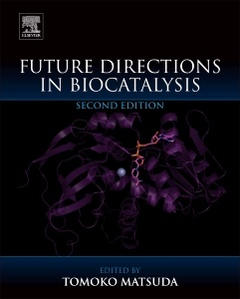Future Directions in Biocatalysis (2nd Ed.)
Coordonnateur : Matsuda Tomoko

Future Directions in Biocatalysis, Second Edition, presents the future direction and latest research on how to utilize enzymes, i.e., natural catalysts, to make medicines and other necessities for humans. It emphasizes the most important and unique research on biocatalysis instead of simply detailing the ABC?s on the topic.
This book is an indispensable tool for new researchers in the field to help identify specific needs, start new projects that address current environmental concerns, and develop techniques based on green technology. It provides invaluable hints and clues for conducting new research on enzymes, with final sections outlining future directions in biocatalysis further expanding the science into new applications.
1. X-ray crystal structure determination 2. Simulation for prediction of enzyme functions 3. Biotransformation in ionic liquid 4. Utilization of light energy for reactions using biocatalysis 5. Utilization of liquid and supercritical CO2 as solvents for biocatalysis
University and industry researchers with their specialties in synthetic organic chemistry, biocatalysis, or enzymology: chemists and chemical engineers, biochemists, researchers in chemical and pharmaceutical industries, reference book for graduate courses in bioorganic engineering and bioengineering
- Gives future directions in the area of biocatalysis research
- Presents research topics based on their uniqueness, originality, and novelty
- Includes many explanatory figures to demonstrate concepts to both organic chemists and biochemists
- Shows that there is no boundary between organic chemistry and biochemistry
Date de parution : 08-2017
Ouvrage de 460 p.
19x23.3 cm
Mots-clés :
(de)carboxylases; 2-arylpropanoic acid; Activation; Acyl-CoA synthetase; Alcohol; Alcohol dehydrogenase; Amidation; Asymmetric reaction; Asymmetric reduction; Biocatalysis; Biocatalytic promiscuity; Bioluminescence; Bioprospecting; Boron-cluster carborane; C-chiral phosphorus compounds; C-chiral sulfur compounds; CO2; Carboxylase; Catalytic reaction; Chiral alcohols; Chiral cyclic amine; Cofactor; Cofactor recycling; Covalent flavinylation; Deazaflavin; Desymmetrization; Domain decomposition; Domino reaction; Dynamic kinetic resolution; Electronegativity; Enantiomer; Enantioselective; Enantioselectivity; Enzyme; Enzymology; Extradiol ring-cleavage dioxygenase; Firefly luciferase; Flavin; Fluorinated compounds; Ge-chiral germanium compounds; Homology modeling; Hydrolase; Hydrolytic enzymes; Imine reductase; Ionic liquids; Ketoreductase; Kinetic resolution; Light emission; Lipase; Lipase-catalyzed reaction; Medicinal chemistry; Metagenomics; Molecular dynamics; Monooxygenases; Nicotinamide; Nonaqueous solvent; Odorous compound; Optically active compound; Oxidases; P-chiral phosphorus compounds; Peptide bond formation; Photobiocatalysis; Prenylated flavin; Racemization; Reaction intermediate; Reactivity; Redox enzymes; Reduction; Ruthenium; S-GAM; S-chiral sulfur compounds; Sequence alignment; Si-chiral silicon compounds; Substrate specificity; Subtilisin; Synchrotron radiation; Thioester formation; Thioesterification; Vanadium; Various biotransformation; X-ray crystallography; X-ray free electron laser (XFEL)



